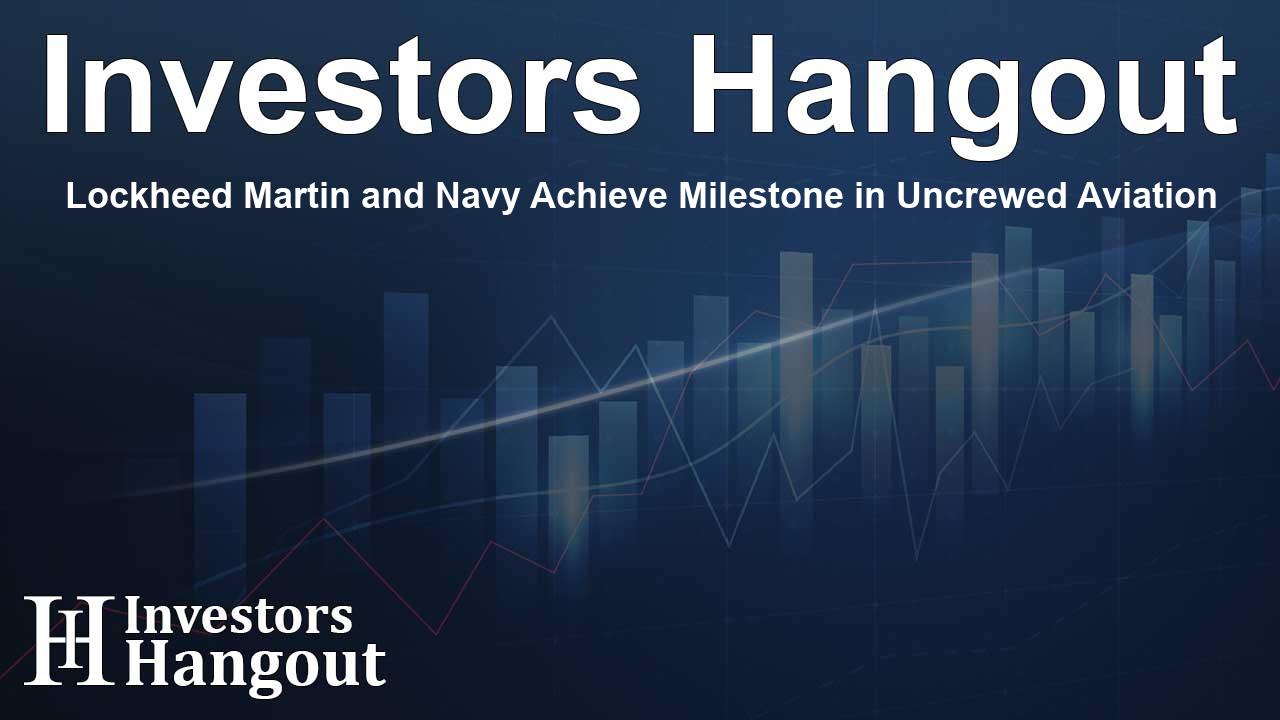Lockheed Martin and Navy Achieve Milestone in Uncrewed Aviation

Lockheed Martin's Groundbreaking Collaboration with the Navy
Lockheed Martin (NYSE: LMT) has reached a significant milestone in partnership with the U.S. Navy. Together, they successfully conducted a live control flight demonstration of an uncrewed air vehicle using the Unmanned Carrier Aviation Mission Control Station (UMCS). This event showcased Lockheed Martin's MDCX™ autonomy platform, which played a crucial role in operating the General Atomics MQ-20 Avenger uncrewed aerial system during the mission.
Enhancing Uncrewed Operations with Advanced Technology
The demonstration, marked as a pathfinder event, aimed at advancing the technologies essential for seamless crewed and uncrewed integrations, which are vital for future programs like the Collaborative Combat Aircraft (CCA). By utilizing the MDCX™ platform, Navy pilots managed to steer the MQ-20 Avenger as it undertook a live flight mission. This benchmark event is paving the way for the Navy's forthcoming operations in unmanned aviation.
Key Highlights of the Flight Demonstration
During the demonstration, the U.S. Navy Air Vehicle Pilots efficiently controlled the MQ-20 from their operations at Patuxent River as it executed tasks over a separate location. The ability to remotely manage unmanned systems not only enhances operational capabilities but also aligns with the Navy's vision for the future of aerial combat.
Statements from Leaders in the Field
John Clark, Vice President and General Manager of Lockheed Martin Skunk Works, expressed pride in their collaboration with the Navy, emphasizing the importance of the MDCX™ in quickly integrating the unmanned systems’ autonomy core with the UMCS. This integration is essential for demonstrating effective common control capabilities and ensuring interoperability with other platforms.
David R. Alexander, President of General Atomics Aeronautical Systems, Inc., highlighted how this collaboration strengthens the UMCS's capabilities beyond line-of-sight. The focus on enhancing autonomous technologies demonstrates their commitment to reflecting real-world readiness in military operations.
The Future of Unmanned Naval Aviation
Lieutenant Steven Wilster, a MQ-25 Air Vehicle Pilot, described the demonstration as a monumental step for unmanned naval aviation. He noted that this event signifies meaningful progress in integrating unmanned capabilities within joint military forces to tackle current and future threats effectively.
Collaborations for Enhanced Defense Mechanisms
The U.S. Navy, along with the Air Force and Marine Corps, is spearheading a Tri-Service Memorandum of Understanding to develop critical sub-systems for CCA platforms. This cooperative effort aims to establish a unified control architecture and ground control stations for these systems, leveraging Lockheed Martin Skunk Works’ extensive experience in delivering ground control solutions that meet the needs of the U.S. government.
The upcoming refinements to the UMCS requirements will be guided by the insights gained from this historic demonstration. Continued flight tests are planned to advance command-and-control technologies, autonomy, and enhance collaboration between crewed and uncrewed systems.
About Lockheed Martin
Lockheed Martin stands as a global leader in defense technology, dedicated to fostering innovations that advance scientific discovery. With a vision focused on all-domain mission solutions and 21st Century Security®, they strive to expedite the introduction of transformative technologies that keep their clients ahead of their challenges.
Frequently Asked Questions
What was demonstrated during the recent flight test?
The flight test showcased the live control of an uncrewed air vehicle using the Unmanned Carrier Aviation Mission Control Station (UMCS) powered by Lockheed Martin's MDCX™ autonomy platform.
What role does the MDCX™ platform play?
The MDCX™ platform is crucial for integrating the autonomy capabilities of unmanned systems, enabling pilots to remotely control the aircraft during missions.
How does this collaboration affect the future of naval aviation?
This collaboration is expected to advance unmanned aviation operations and pave the way for further technological enhancements within the Navy's air capability framework.
What other branches of the military are involved?
The U.S. Navy is working with both the Air Force and Marine Corps through a Tri-Service Memorandum of Understanding to enhance capabilities for the Collaborative Combat Aircraft (CCA) program.
Where can I find more information about Lockheed Martin’s initiatives?
For more detailed information on Lockheed Martin's ongoing initiatives and technologies, please visit their official website.
About Investors Hangout
Investors Hangout is a leading online stock forum for financial discussion and learning, offering a wide range of free tools and resources. It draws in traders of all levels, who exchange market knowledge, investigate trading tactics, and keep an eye on industry developments in real time. Featuring financial articles, stock message boards, quotes, charts, company profiles, and live news updates. Through cooperative learning and a wealth of informational resources, it helps users from novices creating their first portfolios to experts honing their techniques. Join Investors Hangout today: https://investorshangout.com/
Disclaimer: The content of this article is solely for general informational purposes only; it does not represent legal, financial, or investment advice. Investors Hangout does not offer financial advice; the author is not a licensed financial advisor. Consult a qualified advisor before making any financial or investment decisions based on this article. The author's interpretation of publicly available data shapes the opinions presented here; as a result, they should not be taken as advice to purchase, sell, or hold any securities mentioned or any other investments. The author does not guarantee the accuracy, completeness, or timeliness of any material, providing it "as is." Information and market conditions may change; past performance is not indicative of future outcomes. If any of the material offered here is inaccurate, please contact us for corrections.